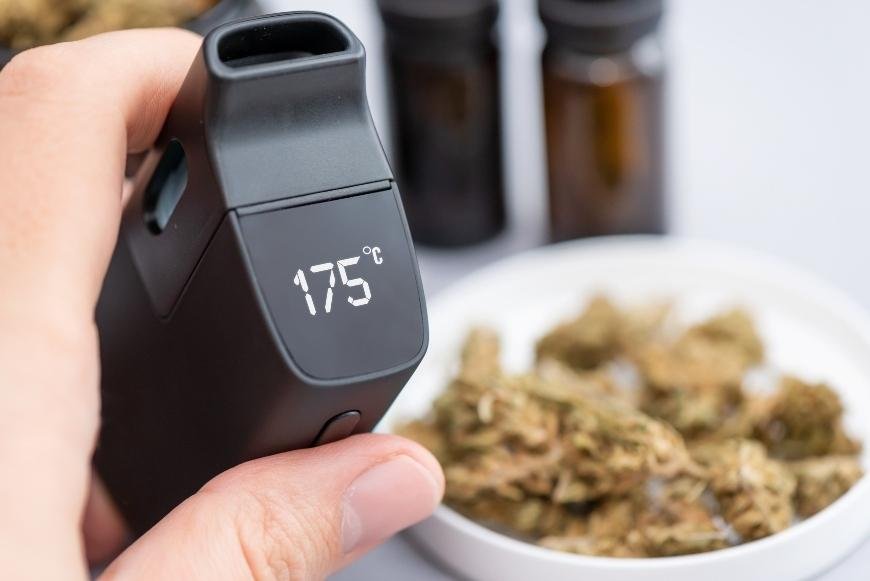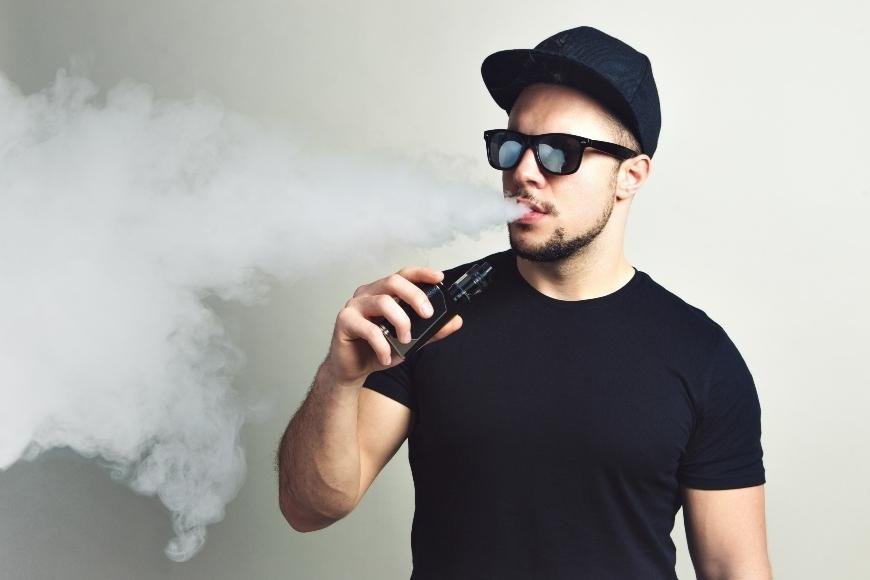Alter Your High With Different Vaporizer Temperatures
Discover how to alter your high with different vaporizer temperatures, maximizing efficiency and personalizing your cannabis experience for the perfect balance.

Altering your high with different vaporizer temperatures can lead to a more customized and enjoyable experience when vaping cannabis. By delving into the science behind cannabinoids and terpenes, their boiling points, and how temperature control can lead to a more customized experience with enhanced effects or flavor profile, this blog post will provide tips on experimenting with different vaporizer temperatures.
We'll explore the ideal temperature settings for each cannabinoid and terpene, providing tips on how to experiment with various temperatures for enhanced psychoactive effects, increased medicinal benefits, or an optimized flavor profile. Additionally, we'll discuss the importance of starting at low temperatures and gradually increasing them during your session.
By understanding how altering vaporizer temperatures affects your high levels and overall experience, you'll be able to find the perfect temperature that suits your personal preferences. So let's dive in!
Table of Contents:
- Understanding Vaporizer Temperatures
- Importance of Customizing Vaporizer Temperature Settings
- Effects of Different Temperatures on Cannabinoids and Terpenes
- Low vs High Temperature Vaping
- Finding Your Ideal Temperature Range
- Terpenoids, Flavonoids & Concentrates in Vaping Cannabis
- Health Considerations & Minimizing Risks
- FAQs in Relation to Alter Your High With Different Vaporizer Temperatures
- Conclusion
Understanding Vaporizer Temperatures
Vaporizer temperatures play a crucial role in determining the psychoactive and medicinal effects of cannabis. Different temperature settings on a vaporizer release specific cannabinoids and terpenes, allowing users to customize their experience. By experimenting with various temperature ranges, individuals can find the optimal setting for personal use while maximizing cannabinoid intake.
Importance of Customizing Vaporizer Temperature Settings
The ability to control your vaporizer's temperature is essential because it allows you to target specific cannabinoids and terpenes. Each compound has its boiling point at which it evaporates most efficiently. For example, THC has a boiling point around 315°F (157°C), while CBD boils at approximately 356°F (180°C). By adjusting your device's temperature settings according to these boiling points, you can ensure that you're getting the desired effect from your vaping session.
Effects of Different Temperatures on Cannabinoids and Terpenes
Different cannabinoids have different boiling points; therefore, they require different vaporization temperatures for maximum efficiency. Lower temperatures typically result in milder effects accompanied by intense flavors due to higher levels of terpenes being released during the process. In contrast, higher temperatures produce more potent psychoactive effects as well as increased medicinal benefits associated with high levels of certain cannabinoids like THC or CBD.
- Lower Temperature: Ideal for beginners or those seeking mild relaxation without an intense high; preserves delicate terpene profiles resulting in richer flavor experiences.
- Moderate Temperature: Suitable for intermediate users or those seeking a balanced high; releases a broader range of cannabinoids and terpenes, providing more well-rounded effects.
- Higher Temperature: Recommended for experienced cannabis consumers or those seeking potent medicinal benefits; may produce stronger psychoactive effects due to higher levels of THC being released.
In addition to cannabinoids, temperature control also plays an essential role in preserving the unique flavors and aromas associated with different cannabis strains. Terpenes are responsible for these characteristics, but they have specific boiling points as well. By experimenting with various temperature settings on your vaporizer, you can find the perfect balance between flavor preservation and desired potency.
By understanding vaporizer temperatures and the effects of different temperatures on cannabinoids and terpenes, you can customize your vaping experience to achieve desired results. Now let's take a look at low vs high temperature vaping to understand their respective benefits.

Low vs High Temperature Vaping
Adjusting your vaporizer's temperature affects not only the intensity but also the quality of your high. The choice between low and high-temperature vaping depends on personal preferences, desired effects, and specific cannabinoids or terpenes you want to experience. Exploring the advantages of both low and high-temperature vaping is discussed in this section.
Benefits of Low-Temperature Vaping
- Better flavor: Vaporizing cannabis at lower temperatures (around 350°F) preserves more terpenes, which are responsible for the herb's unique flavors like citrusy or piney undertones.
- Milder effects: Lower temperature settings release fewer cannabinoids into the vapor, resulting in a less intense high that is suitable for beginners or those seeking mild relief from ailments such as anxiety or stress.
- Prolonged vape battery life: Since it takes less energy to heat up your device at lower temperatures, you can expect longer-lasting battery life with each session.
Advantages of High-Temperature Vaping
- Cannabinoid-rich vapor: Vaporizing cannabis at higher temperatures (above 400°F) releases more psychoactive compounds like THC and CBD into the vapor. This leads to a clearer psychoactive effect recommended for experienced users looking for an intense high.
- Faster onset time: The increased cannabinoid content inhaled during higher temperature sessions typically results in quicker onset times compared to their lower-temp counterparts.
When it comes to finding your ideal temperature, it's essential to understand the boiling points of the cannabinoids and terpenes you want to experience. For example, THC has a boiling point of 315°F, while CBD's boiling point is around 356°F. By knowing these specific boiling points, you can adjust your temperature settings to target the desired effects.
Overall, experimenting with different vaporizer temperatures can enhance your vaping experience and help you achieve your desired effects. Whether you prefer a milder high or intense levels of psychoactivity, adjusting your temperature control can make all the difference. So, find your perfect temperature and enjoy vaping cannabis to the fullest.
Finding Your Ideal Temperature Range
When it comes to customizing your vape experience using different temperature settings, understanding how each cannabinoid reacts at specific degrees Fahrenheit (°F) is essential. By starting within a range between 350-400°F and gradually increasing or decreasing by increments, you can achieve desired results based on factors such as taste preference and potency level required.
THC Boiling Point at Around 315°F
Tetrahydrocannabinol (THC), the primary psychoactive compound in cannabis, has a boiling point of around 315°F. Vaporizing cannabis at this lower temperature will release THC without burning the plant material, providing users with an intense high while preserving terpenes for added flavor. However, be aware that vaping below this threshold may not fully activate all cannabinoids present in your herb.
CBD Boiling Point at Approximately 356°F
CBD, with its therapeutic properties rather than psychoactive effects, has a boiling point of approximately 356°F and can be more effectively accessed by vaping cannabis within this temperature range. Vaping cannabis within this higher temperature range allows users to access CBD's therapeutic benefits more effectively. Keep in mind that some vaporizers may require even higher temperatures to efficiently extract other minor cannabinoids like CBG or CBN.
To find the perfect temperature setting for your personal preferences and needs:
- Begin with a low temperature around 350°F;
- Gradually increase by small increments until reaching desired effects;
- Take note of the temperature settings that produce your preferred balance between flavor and potency;
- Experiment with different strains, as each may require slightly different temperature ranges for optimal results.
Begin with a lower temp, advancing gradually to prevent scorching the plant and maximize vaporizer output. By experimenting with various temperatures, you can unlock new experiences while vaping cannabis, making it an enjoyable journey tailored just for you.
Finding the ideal temperature range for vaping cannabis can help you achieve your desired effects, as each cannabinoid and terpenoid has its own boiling point. To further customize your experience with concentrates or other compounds, it's important to understand how their evaporation rates are affected by different temperatures.
Terpenoids, Flavonoids & Concentrates in Vaping Cannabis
While cannabinoids like THC and CBD are essential components of cannabis, terpenoids and flavonoids also play a significant role in the overall vaping experience. These compounds contribute to the unique aroma and flavor profiles of different strains. In addition, modern vaporizers have evolved to accommodate concentrates as well, requiring users to vape at slightly higher temperatures for optimal results.
Evaporation Rates of Terpenoids and Flavonoids Compared to Cannabinoids
The evaporation rates of terpenes differ from those of cannabinoids due to their specific boiling points. For example, myrcene - a common terpene found in many cannabis strains - has a boiling point around 334°F (168°C), while limonene's boiling point is approximately 349°F (176°C). As such, it's crucial for vapers who want an intense flavor experience with their vaporizing cannabis sessions to experiment with lower temperature settings that preserve these delicate compounds.
- Myrcene: Boiling Point: ~334°F (~168°C)
- Limonene: Boiling Point: ~349°F (~176°C)
- Caryophyllene: Boiling Point: ~320-356°F (~160-180°C)
- Linalool: Boiling Point: ~388°F (~198°C)
Vaping Concentrates and Temperature Adjustments
In recent years, the popularity of concentrated forms like wax or shatter has increased. At these higher temperature settings, it's important to note that vaping can produce potentially harmful byproducts like acetaldehyde or formaldehyde. High temperatures can produce toxic byproducts, so it's important to use a high-quality vaporizer with precise temperature control features when vaping concentrates.
To ensure a safe and enjoyable experience when vaping concentrates, follow these tips:
- Invest in a high-quality vaporizer with precise temperature control features.
- Start at a lower temperature setting and gradually increase until you achieve the desired effects without compromising flavor or safety.
- Clean your vape regularly to prevent residue buildup that could affect performance and taste.
Incorporating terpenoids, flavonoids, and concentrates into your cannabis vaping routine requires attention to detail regarding temperature settings. By understanding how each compound reacts under specific conditions, you can tailor your experience for maximum enjoyment while minimizing potential risks associated with overheating or improper use of your device.

Health Considerations & Minimizing Risks
Vaping may be cleaner than smoking, yet it's still necessary to consider potential toxins inhaled during use in order to minimize risk. To minimize risk, avoid excessively high vaporizing temperatures unless necessary based on your specific strain or situation.
Potential Toxins at Higher Vaping Temperatures
When vaping cannabis at higher temperatures, there is an increased chance of releasing harmful compounds such as benzene and acetaldehyde. These toxins are known carcinogens that can pose health risks when inhaled over time. The ideal temperature range for minimizing toxin production while maximizing cannabinoid extraction lies between 338°F and 392°F (170°C - 200°C). Staying within the recommended temperature range can help reduce exposure to potentially hazardous toxins.
Tips for Minimizing Risks While Enjoying Cannabis Through Vaporizers
- Maintain proper vape battery care: Regularly check your vape battery for any signs of damage or wear and replace it if needed. A damaged battery may cause overheating issues leading to undesirable effects on both flavor and safety.
- Clean your vaporizer regularly: Keeping your device clean ensures optimal performance and reduces the chances of inhaling impurities from residue buildup inside the chamber or mouthpiece.
- Avoid combustion: Combustion occurs when plant material burns instead of being gently heated through convection or conduction methods used by most modern vaporizers; this results in smoke rather than vapor, negating the health benefits of vaping. To prevent combustion, use a vaporizer with temperature control and avoid packing your chamber too tightly.
- Choose high-quality cannabis: Opt for organically grown cannabis free from pesticides or other harmful chemicals to ensure you're inhaling only the purest cannabinoids and terpenes possible.
Incorporating these tips into your vaping routine will help you enjoy the benefits of cannabis while minimizing potential risks associated with higher temperatures and impurities. By staying informed about proper vaporizer usage, maintenance, and ideal temperature settings, you can enhance your overall experience while prioritizing safety and well-being.
FAQs in Relation to Alter Your High With Different Vaporizer Temperatures
What Does Vaping at Different Temperatures Do?
Vaping at different temperatures affects the release of cannabinoids and terpenes, which in turn influences the overall experience. Lower temperatures provide a smoother vapor with more flavor, while higher temperatures produce stronger psychoactive effects and increased medicinal benefits. Experimenting with various temperature settings can help you find your ideal balance for desired effects.
What Temperature Do You Get High on a Vaporizer?
The optimal temperature range to get high on a vaporizer is between 180°C (356°F) and 210°C (410°F). This range allows for efficient extraction of THC, CBD, and other cannabinoids responsible for producing psychoactive effects. However, individual preferences may vary depending on personal tolerance levels and desired outcomes.
How Do You Get the Highest on a Vaporizer?
To achieve maximum potency from your vaporizer, start by setting it to around 210°C (410°F), as this will efficiently extract THC - the primary compound responsible for inducing euphoria. Gradually increase the temperature if needed but be cautious not to exceed 235°C (455°F), as combustion might occur beyond this point.
What Temperature Should Nicotine Vaporizers Be Set At?
Nicotine-based e-liquids are best vaped within a lower temperature range of about 150°C (302°F) to 190°C (374°F). This ensures smooth inhalation without causing irritation or burning sensations while still effectively delivering nicotine into your system. Remember that each device may have specific recommendations; always consult manufacturer guidelines before adjusting any settings.
Conclusion
By understanding the effects of different temperatures on cannabinoids and terpenes, you can customize your vaporizer experience to enhance psychoactive effects, increase medicinal benefits, and optimize flavor profiles. Experimenting with temperature settings can lead to a more enjoyable and personalized high.
To get started, check the manufacturer's instructions for recommended temperature ranges for each cannabinoid and terpene. Start at a low temperature and gradually increase it while monitoring the color of the vapor. With these tips in mind, you can alter your high with different vaporizer temperatures to achieve your desired effect.



































































































































